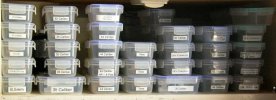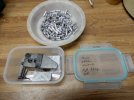Michael
Active Member. Uh/What
Everyone has their favorite method of cleaning a mold before use. I am one of those that always puts some sort of rust preventive on a iron mold after use, then in a small zip-lock and placed inside of a ammo can. My wife quilts, so this routine drives her nuts, she should talk, trimming, pinning, pressing seams, matching points, blah blah blah blah.
Yesterday I tried something different from my usual cleaning regime of acetone, cotton balls and Q-tips. Granted this was just once, with one mold, surely not a large data population, but it turned out pretty well, will give it another go tomorrow.
Gave the blocks a few squirts of Dawn Power Wash, let them sit for a bit while getting other stuff ready and the pot hot. Went back a while later with a tooth bush and hot water, cleaned right up and once up to temp (took 3 cycles- 2 cav, .45 cal, 525gr, pot at 720), worked like a dream.
Yesterday I tried something different from my usual cleaning regime of acetone, cotton balls and Q-tips. Granted this was just once, with one mold, surely not a large data population, but it turned out pretty well, will give it another go tomorrow.
Gave the blocks a few squirts of Dawn Power Wash, let them sit for a bit while getting other stuff ready and the pot hot. Went back a while later with a tooth bush and hot water, cleaned right up and once up to temp (took 3 cycles- 2 cav, .45 cal, 525gr, pot at 720), worked like a dream.
Last edited:


